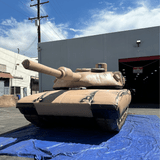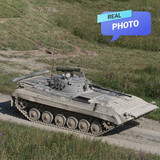Inflatable Army WW2 Magic: balloon tanks ww2
During World War II, these seemingly innocent inflatables played a pivotal role in military training and deception tactics. In this blog, we'll explore the fascinating world of balloon tanks from WWII, their real-world qualities, historical context, and uses. Plus, we'll introduce you to i2k, a manufacturer specializing in creating these ingenious decoys for modern military applications.
What is a Balloon Tank?
In the midst of the Second World War, the need for innovative training methods and cunning deception tactics became paramount. Enter the inflatable tank, a creation that would soon prove to be a game-changer in military operations.
Balloon Tanks in WWII
As the conflict raged on, nations on both sides sought ways to enhance their military capabilities. One remarkable solution was the use of inflatable decoy tanks, designed to simulate real tanks convincingly. These decoys played a crucial role in three key areas: training, protection, and deception.
Training Possibilities: Invaluable Lessons in Airstrikes
In the tumultuous theater of World War II, one of the paramount objectives was preparing troops to effectively combat enemy tanks through aerial attacks.
This task was fraught with challenges. Not the least of which was the sheer cost and risk associated with live-fire tank training. In response, military tacticians turned to a rather unconventional solution: top secret balloon tanks ww2. These remarkable decoys, eerily resembling real armored vehicles, played an indispensable role in training troops to execute precision airstrikes against enemy tanks.
The Costly Reality of Tank Warfare
The true cost of tank warfare extends far beyond the initial investment in steel and machinery. The loss of a single tank not only represents a substantial financial burden. It also diminishes the combat capabilities of a military force. In a conflict where the ability to neutralize enemy tanks (german forces) from the air was of paramount importance, finding a way to train for this without incurring these heavy costs was imperative.
Perfecting Aerial Tank Destruction Techniques
Training exercises around these balloon tanks ww2 were nothing short of transformative. Soldiers could engage in simulated airstrikes against these decoys. Practicing precision bombing and strafing runs without the risk of damage to valuable military assets. This training was about perfecting the art of tank destruction from the air.
Strategic Coordination and Tactics
Soldiers honed their ability to coordinate strikes, track targets, and adapt to changing battlefield conditions. They experimented with various munitions and tactics to maximize the effectiveness of their aerial attacks. Through repeated training, they became masters of the skies. Learning to turn the tables on their adversaries by countering the formidable threat posed by enemy tanks.
The Battlefield Advantage
When real combat scenarios unfolded, these well-trained troops possessed a significant edge. Their ability to destroy enemy tanks from the air with precision strikes minimized the risks and resource expenditures associated with ground-based tank battles. This expertise was not just advantageous; it was strategic, reshaping the dynamics of warfare.
The Tactical and Economic Impact of balloon tanks ww2
Beyond the battlefield, the use of inflatable tanks for training delivered profound tactical and economic benefits. Nations could preserve their actual tank assets for combat while relying on inflatable decoys for training purposes. This not only reduced costs but also prolonged the operational lifespan of their armored forces.
Deception Tactics: Fooling the Enemy with Radar-Reflective Replicas
During World War II, military strategists devised a brilliant plan that hinged on the seemingly innocuous balloon tanks. These inflatable marvels were not just about their resemblance to real tanks; they had a hidden weapon - radar-reflective properties. Let's delve deeper into this ingenious use of balloon tanks to understand how they created chaos and outwitted the enemy.
Radar Deception: A Tactical Masterstroke
In the heat of battle, information is a precious commodity, and radar technology was rapidly evolving during WWII. Radars became indispensable tools for military reconnaissance and tracking enemy movements. Realizing the potential of this technology, military tacticians sought ways to turn it against their adversaries.
Strategic Placement: The Art of Illusion
Imagine this scenario: A vast open battlefield with enemy radar installations scanning the area for signs of an approaching tank division. Unbeknownst to the enemy, among the real tanks were strategically positioned balloon tank decoys. These decoys were not mere inflatables; they were masterfully designed with radar-reflective materials.
The Illusion Unfolds
As the enemy's radar operators diligently scanned the area, they detected what seemed to be a formidable tank division approaching. The radar signals bounced off the balloon tanks just as they would from genuine steel tanks. The enemy's radar screens lit up with blips, confirming the presence of what appeared to be a massive armored force.
Confusion Sets In balloon tanks ww2
The enemy, believing they were facing a powerful tank division, swung into action. They diverted valuable resources, including aircraft and ground forces, to counter this perceived threat. Little did they know that they were falling prey to a meticulously crafted illusion.
The Real Advantage
While the enemy scrambled to defend against the imaginary tank division, the real tank units could maneuver stealthily, exploiting the distraction caused by the balloon tanks. This diversion of enemy forces bought precious time and created opportunities for surprise attacks and strategic maneuvers.
Modern Applications of Balloon Tanks
The legacy of balloon tanks lives on in modern military tactics. Advances in radar technology have only enhanced the effectiveness of radar-reflective decoys. Today, manufacturers like i2k employ cutting-edge materials and design techniques to create inflatable decoys - tank replicas that remain nearly indistinguishable from actual armored vehicles on radar screens.
The Modern Magic of i2k: Reviving Balloon Tanks
Fast forward to the present day, and the legacy of balloon tanks lives on. Meet i2k, a manufacturer specializing in creating high-quality inflatable tank decoys for military use. Their commitment to authenticity and attention to detail make their replicas virtually indistinguishable from the real thing.
i2k's inflatable tanks are utilized for various purposes, including training exercises and modern deception tactics. They're designed to withstand challenging conditions, making them suitable for rigorous military training scenarios.
Balloon tanks from WWII were more than just inflatable novelties. They were strategic assets that contributed significantly to military training and deception tactics. Their legacy endures through manufacturers like i2k, who continue to produce these remarkable decoys for today's armed forces.
As we've seen, the historical context and uses of balloon tanks in WWII were diverse and influential. Whether for training soldiers to fend off airstrikes or outsmarting the enemy with radar deception. These inflatables have left an indelible mark on military history.
Check out more specialized blog posts about historical context and use of inflatable amphibious vehicles here and american tank decoys here.
Recent Posts
-
Transforming Military Strategy: Inflatable Tanks in Ukraine
Transforming Military Strategy: Inflatable Tanks Ukraine Transforming Military Strategy: Infl …11th Mar 2024 -
Iconic Tank Replicas: Sherman and Abrams WW2 fake tanks
Iconic Tank Replicas: Sherman and Abrams WW2 fake tanks At i2k, we understand the significance of …4th Mar 2024 -
Inflatable Army WW2 Magic: balloon tanks ww2
During World War II, these seemingly innocent inflatables played a pivotal role in military train …26th Feb 2024






